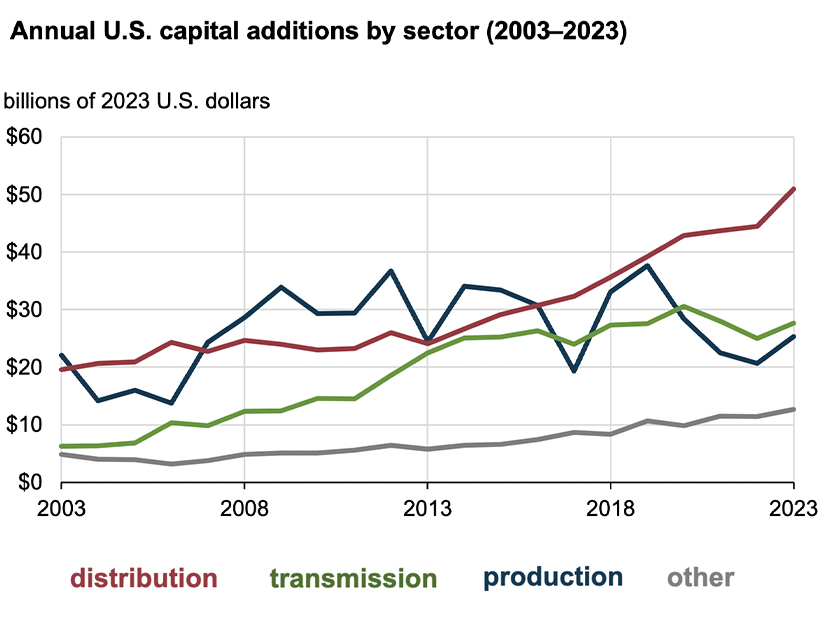
Data collected over the past 20 years shows an increase of 12% in utility capital spending, rising from $287 billion in 2003 to $320 billion in 2023. Spending on generation has declined, while spending on transmission and especially distribution has surged and more than made up for declines in cheap generation, according to data from the U.S. Energy Information Administration.
The sector spends 24% less on producing electricity than it did in 2003 due to lower fuel costs and the closure of older power plants that were costly to maintain. But spending on generation jumped 23%, or $4.7 billion, from 2022 to 2023 due to one project coming online — Southern Co.’s Vogtle nuclear plant expansion, which started commercial operation in April.
Spending on transmission nearly tripled over the two decades, hitting $27.7 billion in 2023, with some of the increase coming from transmission station equipment ($1 billion), poles ($1.1 billion) and computer software ($400 million) needed for operating regional transmission markets.
The distribution system was the main driver for overall increases in the utility sector as capital investments in that level of infrastructure were up by $31.4 billion, or 160%.
More than 20% of the increase in distribution spending happened between 2022 and 2023, when utilities spent $6.5 billion more for a total of $50.9 billion to replace and upgrade aging equipment and install new distribution infrastructure to help neighborhood grids withstand extreme weather and manage renewable intermittency.
The biggest categories for distribution system spending were on overhead lines, poles and towers as utilities spent $17.4 billion on overheard infrastructure in 2023. That marks an 11% increase from a year earlier, and 220% more than in 2003.
Spending on underground lines also ramped up significantly over the past 20 years to reach $11.8 billion in 2023. It was for new developments, as well as undergrounding old lines to mitigate power outages from storms and wildfires or improve neighborhood appearance.
Supply chain and manufacturing issues led to utilities spending 23% more for a total of $7.5 billion in 2023 on “line transformers,” which drop voltage to household levels.
Utilities spent $6.1 billion on distribution substations in 2023, which marks a 184% increase from 2003 and 15% from 2022. More substations allow utilities to better withstand extreme weather, manage renewable intermittency and allow for greater voltage control during emergencies.
Another major increase was spending on infrastructure located on or near customers’ property, which includes meters, leased property and rooftop solar. Utilities spent $5.1 billion on that in 2023, up 84% from 2003 and up 25% from 2022.
Although energy storage remains a relatively small portion of the total budget for distribution infrastructure, spending increased from $97 million in 2022 to $723 million in 2023. Energy storage at the substation or customer site enhances power quality and provides backup power in areas where lines and transformers cannot handle additional capacity, especially as more intermittent renewable resources come online.
The “other” spending category increased by 30% or $8.6 billion over the 20 years. It includes intangible plant expenses like licenses and general plant expenses like office space and storage buildings.


